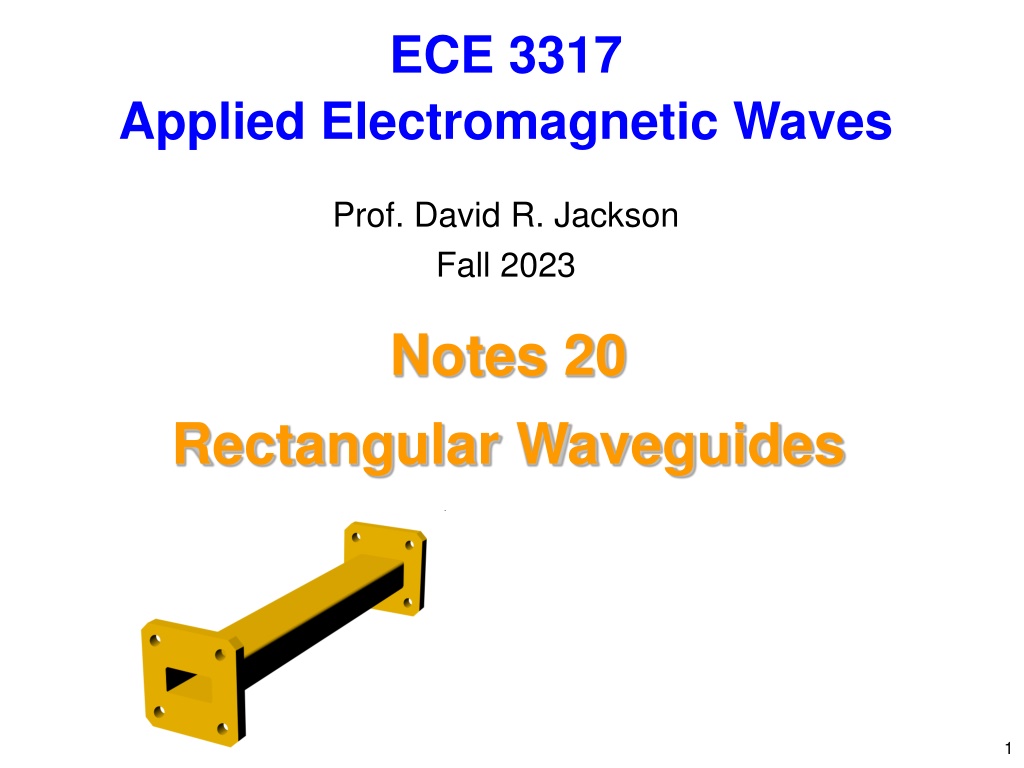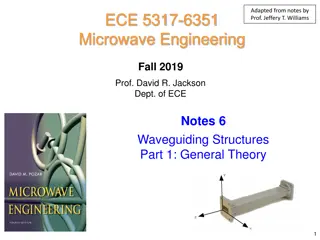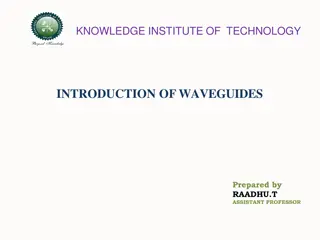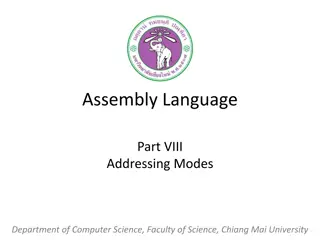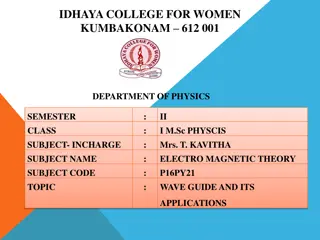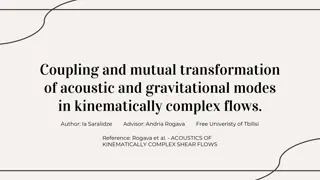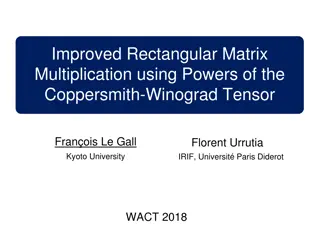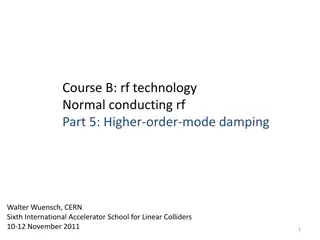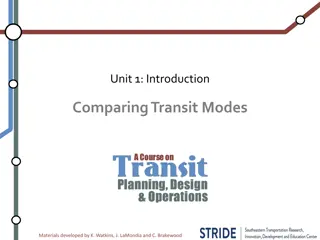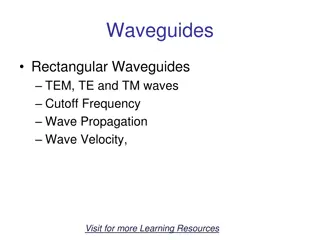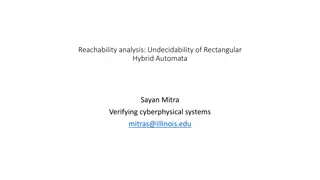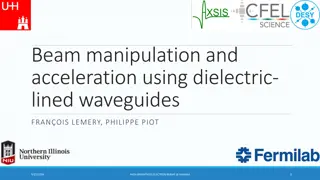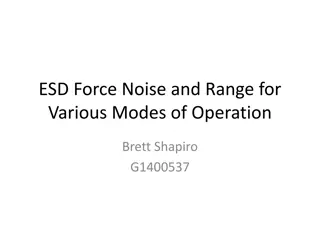Understanding Rectangular Waveguides: Modes and Solutions
Exploring the characteristics of rectangular waveguides, this study delves into the absence of the TEMz mode, the existence of TMz and TEz modes, and the method of separation of variables for solving electromagnetic field equations. The analysis includes the concept of cutoff frequency in lossless waveguides and highlights the intricate relationships between field components in guiding electromagnetic waves.
Download Presentation

Please find below an Image/Link to download the presentation.
The content on the website is provided AS IS for your information and personal use only. It may not be sold, licensed, or shared on other websites without obtaining consent from the author. Download presentation by click this link. If you encounter any issues during the download, it is possible that the publisher has removed the file from their server.
E N D
Presentation Transcript
ECE 3317 Applied Electromagnetic Waves Prof. David R. Jackson Fall 2023 Notes 20 Rectangular Waveguides 1
Rectangular Waveguide Rectangular Waveguide y , b x a Cross section We assume that the boundary is a perfect electric conductor (PEC). No TEMz mode can exist! 2
Rectangular Waveguide (cont.) Why is there no TEMz mode? y z = 0 E b x a = = zk k TEMz mode: 2 2 ( m n ( z ) , m n = 2 Rectangular waveguide mode ( , ): m n k k a b ) ( ) m n , 0,0 ( ) , m n zk k 3
Rectangular Waveguide (cont.) Rectangular Waveguide Two types of modes can exist independently: TMz: Ez only TEz: Hz only 4
Rectangular Waveguide (cont.) Rectangular Waveguide y , b x a Cross section We analyze the problem to solve for Ezor Hz (all other fields come from these). TMz: Ez only TEz: Hz only 5
TMz Modes = 0, 0 H E z z + = 2 2 0 E k E (Helmholtz equation) z z E = 0 on boundary (PEC walls) z ( ) ( ) x y e = jk z , , x y z , E E Guided-wave assumption: z 0 z z 2 2 2 E x E y E z + + + = 2 0 k E z z z z 2 2 2 2 2 E x E y + + = 2 z 2 0 k E k E z z z z 2 2 6
TMz Modes (cont.) 2 2 E x E y ( ) + + = 2 2 z 0 k k E z z z 2 2 2 c 2 2 z k k k Define: 2 2 E x E y Note that kc is an unknown at this point. + + = 2 c We then have: 0 k E z z z 2 2 2 2 E x E y + + = 2 c 0 k E 0 0 z z Dividing by the exp(-j kz z) term, we have: 0 z 2 2 We solve the above equation by using the method of separation of variables. Please see Appendix A for the solution. 7
TMz Modes (cont.) Solution from separation of variables method: TMmn mode m x a n y b ( z ) ( ) , m n = jk z , , x y z sin sin E A e z mn 2 2 m n ( z ) , m n = = 2 2 c 2 k k k k a b 2 2 m n = = k k = + 2 c k 0 r r a b 2 = = = k 0 0 0 c = = 1,2, 1,2, m n 0 Note: If either m or n is zero, the entire field is zero. 8
TMz Modes (cont.) Cutoff Frequency for Lossless Waveguide Note: 2 2 m n ( z ) Cutoff frequency only has a clear meaning in the lossless case (k is real). , m n = 2 k k We start with a b ( ) , m n = 0 zk Set This defines the cutoff frequency. 2 2 m n TM c = = + 2 k f , m n = f f a b c 2 2 c m n c ( ) TM c = + f = d c , m n nonmagnetic material d 2 a b r 9
TMz Modes (cont.) Summary of TMz Solution: TMmn mode m x a n y b ( z ) ( ) , m n = jk z , , x y z sin sin E A e z mn 2 2 m n ( z ) , m n = = 2 2 c 2 k k k k a b = = 1,2, 1,2, m n Note: If either m or n is zero, the entire field is zero. 2 2 c m n TM c = + f d (lossless waveguide) , m n 2 a b 10
TEz Modes = 0, 0 E H z z We now start with 2 2 H x H y ( ) + + = 2 2 z 0 k k H z z z 2 2 ( ) ( ) x y e = jk z , , x y z , H H Guided-wave assumption: z 0 z z 2 c 2 2 z Define: k k k 2 2 H x H y + + = 2 c 0 0 0 z z k H 0 z 2 2 Please see Appendix B for the solution. 11
TEz Modes (cont.) Summary of TEz Solution: TEmn mode m x a n y b ( z ) ( ) , m n = jk z , , x y z cos cos H A e z mn 2 2 m n ( z ) , m n = 2 k k a b = = 0,1,2 0,1,2 m n ( ) ( ) m n , 0,0 2 2 c m n TE c = + (lossless waveguide) f d , m n 2 a b Note: Same formula for cutoff frequency as the TMz case! 12
Summary for Both Modes m x a n y b ( z ) ( ) , m n = jk z , , x y z sin sin E A e TMmn z mn m x a n y b ( z ) ( ) , m n = jk z , , x y z cos cos H A e TEmn z mn 2 2 m n ( z ) , m n = 2 k k same formula for both modes a b c 2 2 c m n = ( ) c , m n = + same formula for both modes d f d c 2 a b r (lossless waveguide) = = 0,1,2, 0,1,2, m n m n = = 1,2, 1,2, m n TMz TEz ( ) ( ) , 0,0 13
Field Plots Color denotes magnitude, arrows show direction of electric field. 14
Wavenumber 2 2 m n = = + 2 2 c TMzor TEz mode: with k k k k c z a b Note: The (m,n) notation is suppressed here on kz. Lossless waveguide: 2 2 m n = = 2 k zk Above cutoff: a b 2 2 m n = j zk Below cutoff: = + 2 k a b ( ) = Recall the general formula for : k k j z z 15
Wavenumber Plot 2 2 m n c k = + k Light line c a b = = 2 k f f cf 2 2 m n = 2 , k f f c a b 2 2 c m n ( ) , m n = = + d f f c c 2 a b 2 2 m n c = + 2, k f f = c c a b d r 16
Guided Wavelength Recall: The guided wavelength g is the distance z that it takes for the wave to repeat itself. 2 = g (This assumes that we are above the cutoff frequency otherwise guided wavelength makes no sense.) After some algebra (see next slide): = d = 0 g (lossless waveguide) ( ) 2 d 1 / cf f r ( ) Note: g d 17
Guided Wavelength (cont.) Derivation of wavelength formula (lossless waveguide): 2 2 2 = = = g 2 2 2 2 c k k m n 2 k a b 2 2 2 = = = = d 2 g ( ) ( ) 2 2 c 2 2 ( ) k k 2 1 / 1 / k k k k k 1 / k k c c c d = = 2 k f = / / k k f f c c = = 2 k f c c c = d g ( ) 2 1 / cf f 18
Dominant Mode The "dominant" mode is the one with the lowest cutoff frequency. Assume b < a y (lossless waveguide) 2 2 c m n = + d f c 2 a b , b c = c x d a r Lowest TMz mode: TM11 TEz Lowest TEz mode: TE10 TMz = = 0,1,2, 0,1,2, m n m n = = 1,2, 1,2, m n ( ) ( ) , 0,0 The dominant mode is the TE10 mode. 19
Dominant Mode (cont.) Summary (TE10 Mode) x ( ) = jk z , , x y z cos H A e z 10 z a 2 = 2 zk k = k k 0 r a c c = = c d a f d c 2 r 2 = 2 , k f f c a 2 = 2, k f f c a 20
Dominant Mode (cont.) Fields of the Dominant TE10 Mode x ( ) = jk z , , x y z cos H A e z 10 z a Find the other fields from these equations (Appendix A of Notes 19): j H y jk E x = E z z z x 2 2 z 2 2 z k k k k j H x jk E y = E z z z y 2 2 z 2 2 z k k k k j E y jk H x = H z z z x 2 2 z 2 2 z k k k k j E x jk H y = H z z z y 2 2 z 2 2 z k k k k 21
Dominant Mode (cont.) Summary of fields for TE10 mode: x ( ) = jk z , , x y z cos H A e z 10 z a x ( ) = jk z , , x y z sin E E e z 10 y a k x ( ) = jk z , , x y z sin H E e z z 10 x a where j = E A 10 10 2 2 z k k a 22
Dominant Mode (cont.) TE10 Mode y y z = 0 E b x x a Length of arrows denotes magnitude of field Color denotes magnitude of field y E H b x a Spacing between arrows denotes magnitude of field 23
Dominant Mode (cont.) TE10 Mode 3D View 24
Dominant Mode (cont.) What is the mode with the next highest cutoff frequency? 2 2 2 c m n c 2 1 / 2 c c ( ) ( ) 1,0 = = + 2,0 = = d a f d f d d f c c c 2 2 2 a a 2 a b 2 1 b c c ( ) 0,1 = = d d f y c 2 2 b Assume b < a / 2 c Then the next highest is the TE20 mode. = c d , r b ( ) ( ) 2,0 1,0 = 2 f f c c x a A 2:1 operating band! (lossless waveguide) Useful operating region TE01 fc TE10 TE20 25
Dominant Mode (cont.) What is the mode with the next highest cutoff frequency? 2 2 2 1 / 2 c c 1 b c c ( ) ( ) 2,0 = = 0,1 = = d d f d d f c c 2 2 a a 2 2 b c y = c d Assume b > a / 2 r (lossless waveguide) , b Then the next highest is the TE01 mode. x The useable bandwidth is now lower than before. a TE01 Useful operating region fc TE10 TE20 26
Dominant Mode (cont.) b a 1 2 ( ) = E H * z dxdy Re P z Power flow in lossless waveguide (f > fc): 0 0 b a 1 2 ( ) = * x Re E H dxdy x y ( ) = jk z , , x y z sin E E e 0 0 z 10 y a a 1 2 = * x Re b E H dx y ab 0 2 = W P E (watts flowing down the waveguide) 10 z 4 (The derivation is omitted, but please see the formula box above.) Note: Above cutoff, there is only watts flowing (no vars). Below cutoff there is no watts flowing (only vars). Make b larger to get more power flow for a given value of a. Keep b smaller than a/2 to get maximum bandwidth. The optimum dimension for b is a/2 (gives maximum power flow without sacrificing bandwidth). 27
Dominant Mode (cont.) Plane wave interpretation of TE10 mode x ( ) ( ) = = jk z jk z , , x y z sin sin E E e E k x e xk z z 10 10 y x a a jk x jk x e e j x x = jk z jz jz e e j E e z = : Note sin z 10 2 2 ( ( ) ) ( ) 10 + / 2 E E j 10 10 = + jk x jk x jk z jk z , , x y z E E e e E e e x x z z 10 y / 2 E E j 10 10 PW #2 PW #1 x / k k a = = tan x 2 PW #1 (E, H) z 2 k a PW #2 z 28
Dominant Mode (cont.) Losses in Waveguide (f > fc) + d c Dielectric loss: 2 ( ) = = 2 0 1 tan k k j j ( ) = Recall : 1 tan j z r d d a rc r 2 Note: ( ) = 2 0 Im 1 tan k j If we are below cutoff, attenuation is mainly due to evanescence, so we don t worry about conductor and dielectric loss then. d r d a Conductor loss: 2 R b f f 2 a b = + r 1 [np/m] s c c ( ) 2 1 / f f 0 c (This is derived in ECE 5317.) 29
Example Find the single-mode operating frequency region for air-filled X-band waveguide. Standard X-band* waveguide: a = 0.900 inches (2.286 cm) b = 0.400 inches (1.016 cm) Note:b < a / 2 Use c ( ) 1,0 = f c 2 a Hence, we have: ( ) 1,0 = 6.56 [GHz] cf X-band waveguide ( ) 2,0 = 13.11 [GHz] cf * X-band: from 8.0 to 12 GHz. 6.56 13.11 [GHz] f 30
Example (cont.) Find the phase constant of the TE10 mode at 9.00 GHz. Find the attenuation in dB/m at 5.00 GHz ( ) 1,0 = 6.56 [GHz] cf Recall: X-band waveguide 2 = 2 , k f f = = = = 2 / 2 / k k f c c a 0 0 0 0 2 = = : : 188.62 [rad/m] 104.79 [rad/m] k k At 9.0 GHz At 5.0 GHz = 2, k f f c a = = / 137.43 [rad/m] ck a At 9.00 GHz: =129.13 [rad/m] At 5.00 GHz: =88.91 [nepers/m] 31
Example (cont.) At 5.0 GHz: = 88.91 nepers/m Recall: X-band waveguide = 8.68589 dB/m = Attenuation 772 dB/m This is a very rapid attenuation! 32
Waveguide Components Straight sections Flexible waveguides Waveguide bends Waveguide adapters Waveguide terminations Waveguide couplers https://www.pasternack.com 33
Waveguide Modes in Transmission Lines A transmission line normally operates in the TEMz mode, where the two conductors have equal and opposite currents. At high frequencies, waveguide modes can also propagate on transmission lines. This is undesirable, and it limits the high-frequency range of operation for the transmission line. 34
Waveguide Modes in Coax Dominant waveguide mode in coax (derivation omitted): 1 1 b a c Note: TE c f TE11 mode: In this notation, the 11 subscript refers to the angular and radial variation. 11 + 1 / a r Example: RG 142 coax = = = = 4 0.035 inches 0.116 inches 2.2 = 8.89 10 29.46 10 [m] [m] a 4 b r a r b = = / 3.3 1 4 8. [ ] 4 b a Z z 0 L C b a TE 16.8 [GHz] cf 11 = = ln 0 Z 0 2 r This coax cannot be used above 16.8 [GHz] 35
Appendix A: TMz Modes 2 2 E x E y ( ) + + = 2 2 z 0 k k E z z We want to solve: z 2 2 2 c 2 2 z k k k Define: 2 2 E x E y Note that kc is an unknown at this point. + + = 2 c We then have: 0 k E z z z 2 2 2 2 E x E y + + = 2 c 0 k E 0 0 z z Dividing by the exp(-jkzz) term, we have: 0 z 2 2 We solve the above equation by using the method of separation of variables. ( ) ( ) ( ) = , E x y X x Y y We assume: 0 z 36
Appendix A (cont.) 2 2 E x E y + + = 2 c 0 k E 0 0 z z 0 z 2 2 ( ) ( ) ( ) = , E x y X x Y y 0 z X Y + = 2 c X Y k XY Hence X X Y Y + = 2 c k Divide by XY : X X Y Y = 2 c k Hence ( ) ( ) Both sides of the equation must be a constant! = F x G y This has the form 37
Appendix A (cont.) X X Y Y = = constant 2 c k = X X = constant 2 x k Denote = + ( ) sin( ) cos( ) X x A k x B k x General solution: x x y = = (0 ( ) ) 0 0 (1) ( ) 2 X X a Boundary conditions: , b x a = = 0 ( ) sin( ) B X x A k x (1) x xk a = sin( ) 0 (2) 38
Appendix A (cont.) From the last slide: xk a = sin( ) 0 This gives us the following result: = = , 1,2 xk a m m m = k x a m x a = ( ) sin X x A Hence Now we turn our attention to the Y (y) function. 39
Appendix A (cont.) We have X X Y Y = = 2 c 2 x k k = Y Y 2 x 2 c k k Hence = 2 y 2 c 2 x k k k Denote = Y Y 2 y k Then we have = + ( ) sin( ) cos( ) Y y C k y D k y General solution: y y 40
Appendix A (cont.) = + ( ) sin( ) cos( ) Y y C k y D k y y y y = = (0 ( ) ) 0 0 (3) ( ) 4 Y Y b Boundary conditions: , b x a = = 0 ( ) sin( ) D Y y C k y (3) y yk b = sin( ) 0 (4) = = , 1,2 yk b n n Equation (4) gives us the following result: n = k y b 41
Appendix A (cont.) n y b = ( ) sin Y y C The Y(y) function is then Therefore, we have m x a n y b ( ) ( ) = = , ( ) sin sin E x y X x Y y AC 0 z New notation: m x a n y b ( ) = , sin sin E x y A 0 z mn The Ez field inside the waveguide thus has the following form: m x a n y b ( z ) ( ) , m n = jk z , , x y z sin sin E A e z mn 42
Appendix A (cont.) = 2 y 2 c 2 x k k k Recall that = + 2 c 2 x 2 y k k k Hence, Therefore, the solution for kcis given by 2 2 m n = + 2 c k a b = 2 c 2 2 z k k k Next, recall that = 2 z 2 2 c k k k Hence 2 2 m n ( z ) , m n = = 2 k k k z a b 43
Appendix B: TEz Modes = 0, 0 E H z z We now start with 2 2 H x H y ( ) + + = 2 2 z 0 k k H z z z 2 2 Using the separation of variables method again, we have ( ) ( ) ( ) = , H x y X x Y y 0 z where = + ( ) sin( ) cos( ) X x A k x B k x x x = + ( ) sin( ) cos( ) Y y C k y D k y y y and = + = 2 c 2 x 2 y 2 z 2 2 c k k k k k k 44
Appendix B (cont.) Boundary conditions: y = = = = ( ,0) ( , ) E x b 0 0 E x (0, ) 0 E y x y , b ( , ) E a y 0 x y x a The result is m x a n y b ( ) = , cos cos H x y A 0 z mn This can be shown by using the following equations: H y H y jk E x j = = 0, 0, y b z = E z z z x 2 2 z 2 2 z k k k k H x jk E y j H x = = = 0, 0, E z z z x a z y 2 2 z 2 2 z k k k k 45
Appendix B (cont.) The Hz field inside the waveguide thus has the following form: m x a n y b ( z ) ( ) , m n = jk z , , x y z cos cos H A e z mn 2 2 m n Same formula for cutoff frequency as the TEz case! ( z ) , m n = 2 k k a b = = 0,1,2 0,1,2 m n ( ) ( ) m n , 0,0 Note: The (0,0) TEz mode is not valid, since it violates the magnetic Gauss law: ( ) ( ) z A e = jkz , , H x y z , , 0 H x y z 00 46
